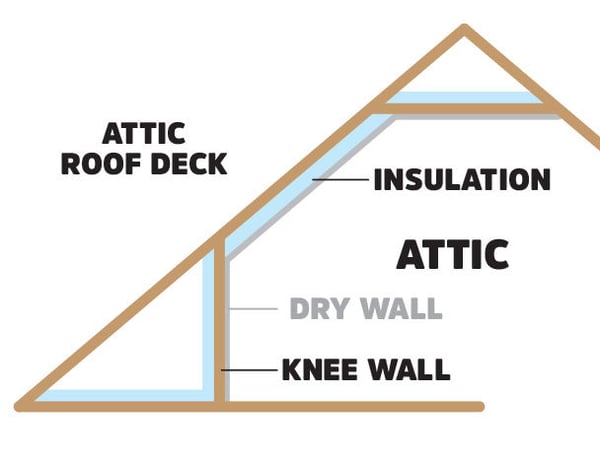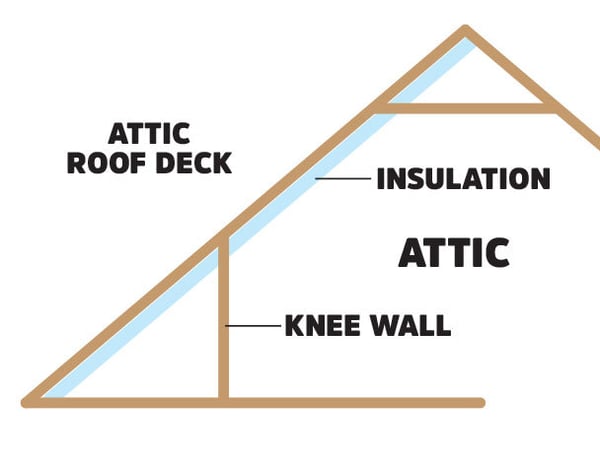How to Add Cape Cod Attic Insulation: Spray Foam the Knee Wall or Roof Deck


There’s more than one way to cook an egg.
There’s also more than one way to add Cape Cod attic insulation, specifically when we’re talking about spray foam.
Most of the time when I go into a Cape Cod house the homeowner has a complaint that the upstairs is too hot or too cold. When I go up to check out the attic, there’s either no insulation or the old insulation they have is falling down off the rafters.
A Cape Cod home has a unique build. This style is where the cold air soaks into the house through that knee wall in the second story and attic area.
So, the options a homeowner has is to spray the roof deck or the knee wall to create an air seal. That air seal is going to keep that air from getting inside the home making the attic and second floor too hot or too cold.
How to Insulate Cape Cod Attic with Spray Foam: Knee Wall vs Roof Deck
Insulating your Cape Cod attic with spray foam is going to help with the issues you’re experiencing, but which method is going to be best for your project?
Here I’m going to explain each method and the benefits of both.
Knee Wall Spray Foam Insulation
 The knee wall is a short wall that supports the rafters of the attic or second floor.
The knee wall is a short wall that supports the rafters of the attic or second floor.
These walls are about 3-feet-tall, but the wall itself isn’t the problem, it’s the space behind it. This is because that space usually doesn’t have any insulation, so air leaks into and out of this space.
Open cell spray foam insulation creates an air barrier and will prevent that air movement on the other side of the knee wall.
For this installation, the attic flat would be sprayed after any old insulation has been removed, along with the knee wall. This method will completely cut that cubby on the other side of the knee wall off from the rest of the conditioned attic space.
While air can still get inside the small space behind the knee wall, but it has no place to go.
Roof Deck Spray Foam Insulation
 Spraying the roof deck of your Cape Cod attic is the other option, and this method has some added benefits.
Spraying the roof deck of your Cape Cod attic is the other option, and this method has some added benefits.
Let’s talk about how it’s done first.
When the roof deck is sprayed with foam after the old insulation has been removed, it’s sprayed on the underside of the roof right through to the cubby behind the knee wall – so from the peak right down to the soffit. This method completely air seals the building envelope of the home, which means you’re not losing air through the roof anymore.
An added benefit of this is that you’ll also be protecting your roof from damage that can be caused by ice dams.
Insulating Your Cape Cod Attic
Now you know what your options are, but I want to share all of my experience as a project manager to give my opinion on what the best method will be.
From my experience, I have found that redoing the attic, then spraying the roof deck in this situation is the best. Spraying from the peak to the soffits will seal the top of the building envelope so that outside air isn’t coming in and all your warm air isn’t escaping out through the roof.
We have a lot of great resources on our website in the Learning Center if you want to learn more about how foam insulation throughout your home can help fix these challenges you face with comfort and energy efficiency.
Related Articles
3 Common Insulation Problems with Cape Cod Houses
About Bruce Vaydik
Bruce has experience helping homeowners achieve their goals to make their homes more comfortable while saving money on monthly energy bills. The flexibility of Bruce’s schedule and meeting new people is the highlight of his day. He also enjoys the help he is able to provide. In his spare time, Bruce works and volunteers at the Chippewa Nature Center in Midland. He is certified in adult and pediatric first aid, CPR, and AED.


